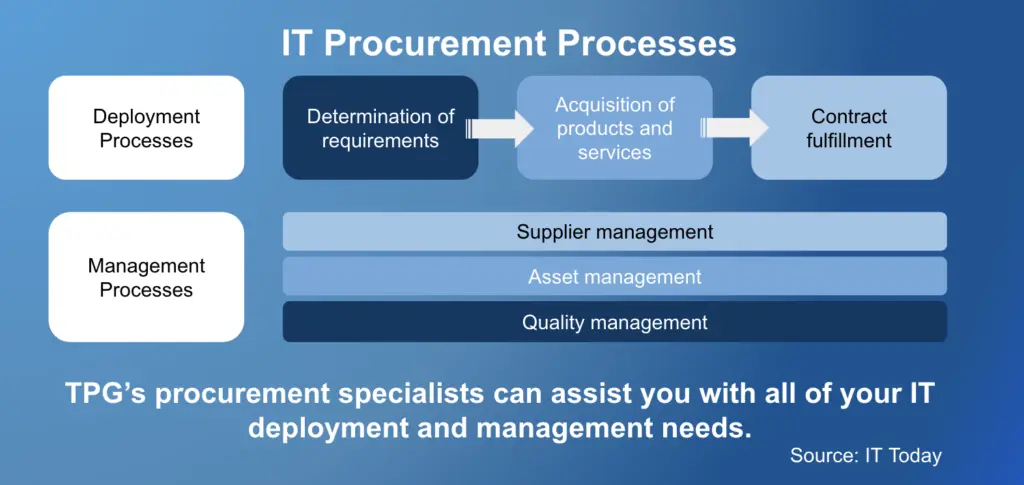In today’s tech-driven world, businesses rely heavily on efficient and effective IT systems to stay competitive. Whether it’s hardware, software, or services, acquiring the right technology is crucial to maintaining smooth operations and fostering growth. This is where IT procurement comes in—a strategic process that ensures organizations get the best value while meeting their technology needs.
This article dives into the ins and outs of IT procurement, exploring its processes, benefits, challenges, and future trends.
What is IT Procurement?
IT procurement refers to the process of sourcing, purchasing, and managing technology assets and services that a business requires. It encompasses:
- Hardware: Devices like servers, laptops, and networking equipment.
- Software: Applications, operating systems, and enterprise solutions.
- Services: Cloud hosting, IT consulting, and managed services.
The goal is not just to acquire technology but to align purchases with business objectives, ensuring cost-effectiveness, scalability, and compliance.
The IT Procurement Process
The IT procurement process typically involves several key stages:
- Needs Assessment and Budgeting:
- Identify the technology requirements based on current and future business needs.
- Establish a budget that aligns with the organization’s financial constraints.
- Vendor Selection and Negotiation:
- Research potential vendors and evaluate their offerings.
- Negotiate contracts to secure the best terms, including pricing, warranties, and support services.
- Purchase and Deployment:
- Finalize the purchase agreement and oversee the delivery of assets or services.
- Ensure proper deployment and integration into existing systems.
- Evaluation and Feedback:
- Review the performance of the procured technology.
- Collect feedback from stakeholders to improve future procurement decisions.
This structured approach minimizes risks and maximizes value from technology investments.
Benefits of Strategic IT Procurement
Strategic IT procurement delivers several advantages to businesses:
- Cost Efficiency and Resource Optimization:By evaluating vendors and products thoroughly, businesses can secure cost-effective deals and avoid overspending on unnecessary features.
- Better Vendor Relationships:Strategic procurement fosters long-term partnerships with reliable vendors, ensuring better service, faster support, and favorable terms.
- Enhanced Technological Alignment:Procuring technology that aligns with business objectives enhances productivity, scalability, and competitiveness.
- Risk Mitigation:Properly structured contracts and compliance checks reduce the risks associated with vendor lock-in and legal issues.
Common Challenges in IT Procurement
Despite its benefits, IT procurement comes with challenges:
- Managing Budgets and Timelines:IT purchases often exceed budgets or face delays due to poor planning or unforeseen costs.
- Vendor Lock-In Risks:Relying heavily on a single vendor can limit flexibility and increase costs in the long term.
- Navigating Compliance and Regulations:Ensuring compliance with data protection laws, licensing agreements, and industry standards requires meticulous attention.
- Rapid Technological Changes:The fast-paced nature of technology can make assets obsolete quickly, requiring businesses to stay agile and forward-thinking.
IT Procurement Best Practices
To overcome challenges and maximize benefits, businesses should follow these best practices:
- Establish Clear Requirements:Clearly define the organization’s needs to avoid over-purchasing or under-purchasing technology.
- Develop Vendor Evaluation Frameworks:Use criteria such as cost, quality, scalability, and support to compare vendors objectively.
- Conduct Regular Contract Reviews:Periodically review vendor contracts to ensure terms remain favorable and aligned with changing needs.
- Leverage Technology Management Tools:Utilize procurement platforms and IT asset management tools to streamline processes and track purchases.
Tools and Software for IT Procurement
Modern IT procurement relies heavily on advanced tools to ensure efficiency:
- SAP Ariba: For procurement management and supplier collaboration.
- Coupa: A comprehensive platform for spend management.
- ServiceNow: Helps manage IT assets and procurement workflows.
- GEP SMART: An AI-driven solution for procurement optimization.
When choosing a tool, consider features like integration capabilities, analytics, and ease of use.
How IT Procurement Aligns with Business Goals
IT procurement plays a vital role in achieving broader business objectives:
- Supporting Digital Transformation: Acquiring innovative technologies enables businesses to modernize operations and remain competitive.
- Enabling Scalability: Flexible procurement ensures businesses can scale their IT infrastructure as they grow.
- Driving Innovation: Strategic investments in AI, IoT, and cloud technologies enhance business capabilities.
By aligning procurement with business goals, organizations can create a robust foundation for long-term success.
Case Studies
Case Study 1: Enhancing Operational Efficiency
A mid-sized retail chain streamlined its inventory management by procuring a cloud-based ERP solution. The result? Improved stock tracking, reduced waste, and enhanced decision-making.
Case Study 2: Avoiding Vendor Lock-In
A healthcare provider diversified its software providers, mitigating risks associated with single-vendor dependency and ensuring continuity during service disruptions.
Future Trends in IT Procurement
The landscape of IT procurement is evolving, driven by innovation and changing business needs:
- AI and Automation:AI tools are enabling smarter decision-making, from vendor selection to contract negotiation.
- Sustainable Procurement:Businesses are prioritizing eco-friendly technologies and green practices to align with corporate social responsibility goals.
- Subscription-Based Models:The shift to SaaS and pay-as-you-go models is changing how businesses approach IT purchases, offering flexibility and cost control.
- Focus on Cybersecurity:As cyber threats rise, procurement strategies increasingly emphasize security features and compliance.
Conclusion
Effective IT procurement is more than just buying technology—it’s about strategically investing in the right tools, services, and partnerships to drive business success. By following best practices, addressing challenges, and staying ahead of trends, businesses can optimize their procurement process and achieve lasting benefits.
As technology continues to evolve, adopting a forward-thinking approach to IT procurement will be critical for staying competitive and resilient in the digital age.
FAQs
What are the main stages of the IT procurement process?
The stages include needs assessment, vendor selection, purchase, deployment, and evaluation.
How can businesses avoid vendor lock-in during procurement?
By diversifying vendors, negotiating flexible contracts, and ensuring compatibility with open standards.
What tools are recommended for managing IT procurement?
Popular tools include SAP Ariba, Coupa, ServiceNow, and GEP SMART for streamlined procurement management.
How does IT procurement contribute to cost savings?
Strategic procurement minimizes unnecessary expenses, optimizes vendor contracts, and ensures resource efficiency.
What role does IT procurement play in digital transformation?
IT procurement enables businesses to acquire cutting-edge technologies that modernize operations, enhance scalability, and foster innovation.

